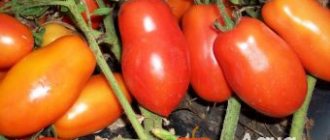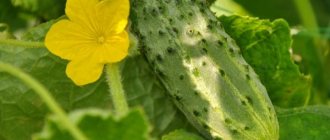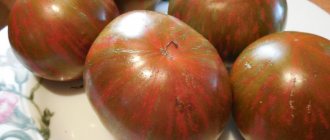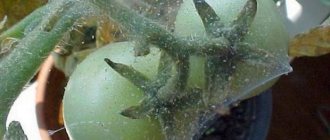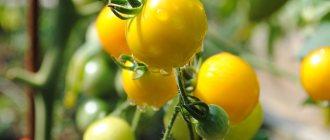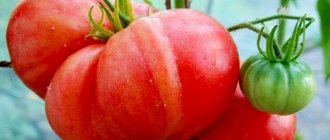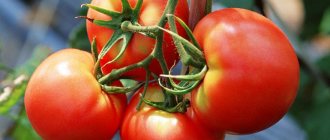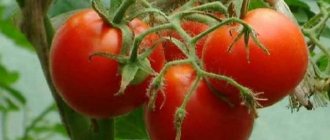Tomato Grozdeva is one of the most productive hybrids among the early ripening group. It is a raceme variety; on the bushes, tomatoes ripen in friendly, neat clusters.
| Height | Landing location | Ripening time | Fruit color | Fruit size | Origin | Fruit shape |
| Tall | Greenhouse, Open ground | Early ripening | Reds | Average | Hybrid | Plum-shaped or oval |
History of variety selection
Tomato Grozdevoy F1 belongs to the first generation hybrid varieties, as indicated by the designation F1 in the name. This variety is an achievement of Russian breeders from; it was included in the State Register of the Russian Federation in 2010 and is recommended for cultivation under film shelters not only in the central, but also in the northern regions.
Cluster F1 belongs to the cluster tomatoes, which are characterized by the setting and ripening of fruits in the form of a cluster. They are more resistant to both diseases and climatic conditions.
This type also includes:
- French grape;
- Black grape;
Video: Tomato variety French bunch
- Siberian grozdevoy.
Growing French bunch tomatoes
The French grape tomato, bred by Russian breeders, is a well-proven hybrid. Easily tolerates cool climates with short daylight hours, suitable for growing in the northern part of Russia.
Growing French bunch tomatoes
Description of the variety
French bunchberry - a variety grown in greenhouses at stable air temperatures, can bear fruit until the first frost, yielding up to 3-4 kg per bush. If the seedlings are planted in open ground, their yield is maintained, but the fruiting period is reduced (until early September).
According to the description, the French bunch tomato variety is a determinant - the growth of the tops stops when the bush reaches a certain size. Gardeners have discovered a pattern that more branched and developed plants bear more fruit, so the French species requires feeding throughout the growing season.
Tatyana Orlova (Vasilidchenko) (candidate of agricultural sciences):
It will not be a big discovery that tomato bushes from which the stepsons are not removed are more productive than those with stepsons. A technique such as pinching is used only in regions unfavorable for growing tomatoes in order to guarantee an early but small harvest.
Fruit
The average weight of one fruit rarely exceeds 100 g. One of the interesting characteristics of ripe vegetables is their elongated pear-shaped shape. The tomato has a small “spout”. This feature distinguishes the variety from the Cornabel F1 tomato, which in appearance resembles a bell pepper.
Characteristics and description of the variety
A productive, early-ripening tomato hybrid variety, Grozdevoy F1, begins bearing fruit 100–105 days after full germination.
Tomato Grozdevoy F1 belongs to indeterminate varieties, the growth of which is unlimited if you do not pinch the top of the stem. Pinching should be done not immediately behind the brush, but through two true leaves: the presence of these leaves will ensure the ripening of the last bunch. Formed mature bushes are powerful and tall, with a moderate amount of small green leaves and clusters of fruit.
Clusters are formed along the entire height of the stem after every third leaf, quite high, starting from 9–11 leaves. A bunch of 8–10 fruits ripen at the same time. Fruiting is abundant and long lasting.
The hybrid tolerates drought well, is adapted to temperature fluctuations and is suitable for growing in areas with short summers. When sown in early March, ripening occurs in July - under favorable weather conditions and correct agricultural technology.
Video: Tomato variety Grozdevoy F1
The fruits are small, juicy and sweet and sour. The weight and size of the fruit make the variety convenient for pickling and whole-fruit preservation. Can be dried, dried, frozen and used fresh in salads.
In middle and northern latitudes it is best to grow it in a greenhouse. In the southern regions, cultivation in open ground is possible, but the bushes will be less tall, the number of ovaries will be smaller, and, accordingly, the yield will be lower.
Productivity
Tomato Grozdeva F1 is superior in yield to many examples of domestic and foreign selection. The stability of the yield does not change during the entire cultivation of the variety.
The total yield of the variety is 19.1 kg of tomatoes per 1 m². Productivity can be increased by growing the plant in two stems. It bears fruit from mid-summer until frost.
Did you know? The fruits of wild tomatoes, found in Latin America, weigh only 1 g, and the weight of cultivated varieties of tomatoes reaches 1 kg or more.
Description of the fruit
The fruits of the Grozdevoy F1 variety are all even relative to each other, ripen together, and have an oval-elliptical shape with a pointed “nose”. Unripe fruits are light green in color, and when ripe they acquire a classic bright red color.
The fruits are fleshy, sweet, medium-sized (closer to small-fruited) weighing 85–100 g. The number of seed nests is 2. The skin is dense, which prevents cracking. There is no white frame under the skin.
The fruits tolerate transportation well without losing their taste.
Description and characteristics of the French grape tomato variety, its yield
If you come across a French bunch tomato, be sure to buy a bag, you won’t regret it. Many varieties of Siberian selection have been tested in summer cottages by hardworking gardeners, this variety is one of them.
Graceful, elongated fruits correspond to the name. Beautiful clusters decorate compact tomato bushes from mid-summer to autumn.
Description
For those who grow seedlings on their own, an important characteristic is the ripening period. Knowing it, you can easily determine the timing of sowing seeds for seedlings. Judging by the description of the tomato, French grape variety is universal. It can be planted with equal success both in the ground and in a greenhouse.
Advantages and disadvantages of the variety
- The advantage of this variety is that it fulfills the basic requirements for this type of vegetable:
- large bushes;
- abundance of fruits;
- beauty and excellent taste of tomatoes;
- disease resistance;
- good fresh storage and high marketability.
- The disadvantages, or rather inconveniences, of the variety include the following:
- tomato Grozdevoy F1 - hybrid. Seeds must be purchased in specialized stores;
- frequent brush formation requires more fertilizer;
- The plants are tall and have weak stems; they may lie down under the weight of the fruit, so reliable support and garter are necessary.
Acceptable terms for cultivation
The timing of sowing tomato seeds must be calculated based on the planned harvest date, weather conditions and climatic factors of the growing region.
It is best to sow tomato seeds of the Grozdeva variety in early March, so that by the end of the spring season the seedlings reach the age of 50–60 days and are ready for transplanting into the ground.
Important! Seed material should not be selected for further cultivation. The advantages of the parent plants will inevitably be lost, which will affect the quality and quantity of the harvest.
Features of growing the variety
To get a harvest, you should take into account the characteristics of growing tomatoes.
Growing seedlings
The Grozdeva tomato variety is grown by seedlings, but in the southern regions, under favorable conditions, it is possible to plant the seeds 3-4 cm into the ground with further care as for ordinary seedlings. Such seedlings are able to catch up with seedling plants and quickly adapt to natural conditions.
It is better to grow seedlings yourself - when buying seedlings at the market, you can make a mistake with the variety and introduce plant diseases into the area.
The seeds are soaked in potassium permanganate and biostimulants (Epin). The planting depth of seeds prepared for sowing is 1 cm. Seedling containers are covered with cellophane or glass and placed in a warm place. The optimal temperature is +20...+24°C to ensure proper growth and development of tomatoes at the initial stage.
When the seedlings have appeared and the seedlings have become stronger, hardening can be carried out by moving the seedling containers to a room with a lower temperature, but not lower than +8°C.
They begin to dive and water the seedlings abundantly after the appearance of the second leaf. The sprouts dive into freer seedling containers, deepening to the cotyledon leaves. Tomato seedlings stretch out greatly, so the containers are removed from a sunny place.
Tilling the land for planting seedlings
A healthy and strong plant can only be grown in well-cultivated and fertile soil. Planting in uncultivated soil risks infection and pests.
To obtain tomato seedlings, you need to prepare the soil mixture:
- turf soil, humus, sand in a ratio of 6:3:1;
- peat, sawdust, greenhouse soil in a ratio of 1:1:2.
Did you know? Every year, 60 million tons of tomatoes are produced worldwide. While bananas - 44 million tons, apples - 36 million tons, oranges - 34 million tons.
To the soil mixture (for every 10 l) add 15–20 g of ammonium nitrate or carbonite, 50–60 g of superphosphate, 15–20 g of potassium sulfate and a half-liter jar of ash. Then the soil must be treated with a hot pale pink solution of potassium permanganate, allowed to cool and the seedling container filled.
To facilitate and speed up spring work, holes for planting tomatoes can be prepared directly on the site in the fall. A bucket of rotted manure, humus and sand is poured into the holes. The soil removed from the holes is filled to the top, 80 g of nitroammophoska and a half-liter jar of ash are added. In the center you can place a peg for future gartering of stems. The soil frozen over the winter will rid the plants of diseases and pests.
Technology of planting seedlings
When growing tomatoes, you need to observe crop rotation. The best predecessors are cabbage, garlic, legumes, cucumbers, onions, and carrots. Areas after potatoes, peppers, eggplants, and beets should be avoided.
The site for planting seedlings should be in a sunny place. Wind and draft are not a hindrance for tomatoes - it provides air ventilation and promotes pollination. But until the seedlings have matured, they should be protected from bad weather and bright sun.
You need to plant seedlings in a permanent place in the evening or in cool weather.
The seedling planting pattern is 40–60 cm between sprouts and 70–100 cm between rows, so that neighboring bushes do not overlap each other’s foliage. Each plant needs a sufficient amount of light and adequate ventilation for full development. Shading can cause diseases in tomatoes.
To avoid damage to the roots, replanting into the ground should be carried out using the transshipment method with deepening to the first leaves. Overgrown seedlings can be placed horizontally in the hole, which promotes the formation of additional lateral roots.
Important! If you shorten the central root of the seedling by a third, you can get a stronger and more branched root system.
Before flowering, fruit setting and ripening, the plantings can be treated with copper-containing preparations.
French grape tomato
photo author Mira Tom
Description and characteristics of the French grape tomato variety, reviews, photos
A productive, mid-season, pickling tomato variety from Siberian breeders.
Determinate type bush, up to 1 meter high. The variety is intended for cultivation in open ground and in greenhouses. Can be grown without pinching.
Basic qualities of fruits
photo author Evgeny Balashov
Tomatoes are finger-shaped, even, smooth, dense, beautiful, bright red in color at ripeness, weighing 80-100 grams. They have good taste, excellent shelf life and transportability, and do not crack. The fruits grow in clusters, with 8-12 pieces in one cluster.
The variety is very convenient for autumn preparations; canned fruits will be an unrivaled delicacy on your table.
Advantages of the variety : resistance to major tomato diseases, excellent commercial quality of the fruit.
Productivity : up to 3.5 kg of fruits from 1 bush (with proper agricultural technology).
The French grape variety of tomato is not included in the State Register of Breeding Achievements in the Russian Federation.
Seed producer : agricultural company Siberian Garden.
Features of cultivation, planting and care
photo author Konstantin Shumsky
The photo shows French grape tomato seedlings.
We recommend sowing the seeds of this tomato variety for seedlings 60-65 days before the intended planting in the ground. Seedlings dive at the stage of two true leaves. When planting seedlings in a permanent place per 1 sq. It is recommended to place up to 4 plants per meter of land.
Further care for tomatoes consists of timely watering, fertilizing with complex mineral fertilizer, pinching and preventive measures to protect against diseases and pests.
Tomato variety French bunch on video
If you grew French bunch tomatoes, please write whether you liked them or not. What was the yield and taste of the fruits like under your climatic conditions? How do you rate the disease resistance of this tomato? Write briefly the advantages and disadvantages of this tomato in your opinion. If possible, attach to the comment a photo of the entire bush as a whole or individual fruits that you grew. Thank you!
Your reviews of the French grape tomato and additions to the description will help many gardeners evaluate this variety objectively and decide whether it is worth planting or not.
Features of caring for Grozdeva F1 tomato
Tomatoes respond with gratitude to proper care and adherence to the rules of agricultural technology.
Watering rules
The tomato consists of 93% water and is very sensitive to lack of moisture, so organizing proper watering is simply necessary:
- Tomatoes do not like water treatments. Excess moisture harms the plant - the green mass increases to the detriment of the development of ovaries on the first inflorescences.
- Watering is carried out with warm water when the soil dries in the morning or evening hours directly under the root, avoiding water getting on the stems and leaves.
- After watering the seedlings abundantly when planting them in the garden, do not water them for the first seven days. The roots go deeper in search of moisture and develop intensively - as a result, the plant becomes resistant to drought.
- With the appearance of fruits, watering is carried out several times a week, depending on weather conditions. Water consumption during this period can be up to 5 liters per 1 square. m.
- With the irrigation method, water comes closer to the roots and the soil is not compacted.
- Drip irrigation is considered the best method - irrigation is carried out at any time of the day.
- To avoid the tedious work of watering and weeding, you can use the method of mulching with straw, sawdust or dark film to retain moisture in the top layer of soil.
Tomato "French grape": a popular variety among amateurs and professionals
This variety is quite young, bred by Russian breeders. Although the variety is not included in the State Register, the “French Bunch” tomato still managed to gain enormous popularity among amateurs and professionals, reviews and photos of the yield of which are evidence of the uniqueness of this variety.
general information
Let's take a closer look at the French Bunch tomato, the characteristics and description of which are detailed below.
Characteristics and description
Description of the bush
This tomato variety has a large and strong bush. In greenhouses it can reach two meters. Some gardeners nicknamed it “long-lasting”, for its ability to bear fruit for a very long time.
But in the Southern regions there is no need to plant a shoot; with sufficient nutrition, the bush will bear fruit until late autumn.
Attachment to supports is necessary both in the greenhouse and in open ground.
Description of fruits
Resistance to diseases and pests
Like all the newest varieties that have good immunity to diseases, the French Bunch tomato variety is resistant to viruses and pests.
But hoping for its stability and not engaging in prevention, of course, is not worth it.
By following simple rules, your tomatoes will forget about their problems. Prevention consists of:
- in regular spraying with solutions against diseases and viruses;
- ventilation of the room after watering and during the day;
- Tinctures of garlic, yarrow, wormwood and celandine help against pests.
Advantages and disadvantages of the variety
Studying the characteristics of the “French Bunch” variety, we can say that it has more advantages than disadvantages. What are they?
At a stretch, several points can be considered as disadvantages:
- Requires mandatory support and garters. But almost all varieties taller than 50 cm require support, so you can argue with the minus.
- Not suitable for open ground in the middle zone and northern regions. This means that it should be planted in those regions only in greenhouses.
To summarize, we conclude: if you deliberately chose the “French Bunch” tomato variety, then you will not find any disadvantages in it!
Features of growing the variety
The “French Bunch” tomato does not require special conditions; it is considered unpretentious, but cultivation of this and other varieties should not be left to chance.
In order not to be disappointed by the yield, which can reach up to 10 kg, you need to follow simple rules. Before sowing, soak the seeds for an hour in a solution of potassium permanganate. Sow 65–70 days before the expected date of planting seedlings in the ground. Seeds are sown in low boxes with ready-made light soil. When two true leaves appear, the seedlings dive into cups, and so that the seedlings and seedlings do not stretch out, they observe the temperature and light conditions.
Water the seedlings moderately, loosen the soil and fertilize with potassium and phosphorus fertilizers alternately every two weeks. This is important for the formation of the root system and healthy foliage.
When the seedlings have 5-6 leaves, it is necessary to water them with a solution of the “Confidor” preparation to protect them from pests.
Planting in a greenhouse takes place in mid-May, when the soil warms up to at least 17⁰.
The hole must be well deepened and prepared accordingly: humus at least 1 liter, ash from straw or grass 1 liter and a handful of mineral fertilizers such as azophosphate or superphosphate.
Immediately prepare everything for watering and staking: the bush is powerful, so the stake or trellis must be reliable. Pour at least 5-6 liters of warm water and mulch.
What does mulch do?
- no crust after watering;
- no weeds;
- roots are not exposed;
- moisture is retained;
- the temperature regime at the roots is observed.
After planting the seedlings, all that remains is to apply the little secrets, and then we will get a harvest from healthy plants.
Water not often: once a week, but generously, using only warm water.
Another secret: shaking the plants for pollination: this promotes the setting of all flower stalks.
It is important to cut off not only the extra shoots, forming 3 or 4 trunks, but also all the lower leaves up to the first cluster gradually, one leaf per week.
Plants need organic matter only during the growth period, and cannot be added during the fruiting period!
Therefore, all fertilizing with organic matter should be done while the tomatoes are growing and blooming. Together with root feeding, spraying with microelements once every 7 days in cloudy weather or in the late afternoon is effective: 1 teaspoon of urea per 10 liters of water, potassium nitrate in the same proportion. By alternating these feedings, you will be pleasantly surprised to see how the plants respond with green, healthy foliage and a mass of ovaries.
When most of the fruits are formed, stop all feeding and reduce watering significantly.
This little parting word that we gave you on caring for French bunch tomatoes, as well as reviews, tips and photos on growing them, will help you grow a decent harvest.
Good luck to you on your fertile beds!

